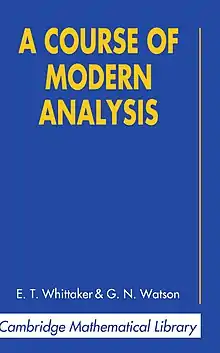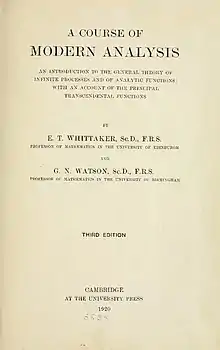A Course of Modern Analysis
A Course of Modern Analysis: an introduction to the general theory of infinite processes and of analytic functions; with an account of the principal transcendental functions (colloquially known as Whittaker and Watson) is a landmark textbook on mathematical analysis written by E. T. Whittaker and G. N. Watson, first published by Cambridge University Press in 1902.[1] The first edition was Whittaker's alone, but later editions were co-authored with Watson.
 Cover of a 1996 reprint of the fourth edition of the book. | |
| Author | E. T. Whittaker and G. N. Watson |
|---|---|
| Language | English |
| Subject | Mathematics |
| Publisher | Cambridge University Press |
Publication date | 1902 |

History
Its first, second, third, and the fourth, last edition were published in 1902, 1915, 1920, and 1927, respectively. Since then, it has continuously been reprinted and is still in print today.
The book is notable for being the standard reference and textbook for a generation of Cambridge mathematicians including Littlewood and G. H. Hardy. Mary Cartwright studied it as preparation for her final honours on the advice of fellow student V. C. Morton, later Professor of Mathematics at Aberystwyth University.[2] But its reach was much further than just the Cambridge school; André Weil in his obituary of the French mathematician Jean Delsarte noted that Delsarte always had a copy on his desk.[3] In 1941 the book was included among a "selected list" of mathematical analysis books for use in universities in an article for that purpose published by American Mathematical Monthly.[4]
Notable features
Some idiosyncratic but interesting problems from an older era of the Cambridge Mathematical Tripos are in the exercises.
The book was one of the earliest to use decimal numbering for its sections, an innovation the authors attribute to Giuseppe Peano.[5]
Contents
Below are the contents of the fourth edition:
- Part I. The Process of Analysis
- Complex Numbers
- The Theory of Convergence
- Continuous Functions and Uniform Convergence
- The Theory of Riemann Integration
- The fundamental properties of Analytic Functions; Taylor's, Laurent's, and Liouville's Theorems
- The Theory of Residues; application to the evaluation of Definite Integrals
- The expansion of functions in Infinite Series
- Asymptotic Expansions and Summable Series
- Fourier Series and Trigonometrical Series
- Linear Differential Equations
- Integral Equations
- Part II. The Transcendental Functions
- The Gamma Function
- The Zeta Function of Riemann
- The Hypergeometric Function
- Legendre Functions
- The Confluent Hypergeometric Function
- Bessel Functions
- The Equations of Mathematical Physics
- Mathieu Functions
- Elliptic Functions. General theorems and the Weierstrassian Functions
- The Theta Functions
- The Jacobian Elliptic Functions
- Ellipsoidal Harmonics and Lamé's Equation
Reception
Reviews of the first edition
George Mathews, in a 1903 review article published in The Mathematical Gazette opens by saying the book is "sure of a favorable reception" because of its "attractive account of some of the most valuable and interesting results of recent analysis".[6] He notes that Part I deals mainly with infinite series, focusing on power series and Fourier expansions while including the "elements of" complex integration and the theory of residues. Part II, in contrast, has chapters on the gamma function, Legendre functions, the hypergeometric series, Bessel functions, elliptic functions, and mathematical physics.
Arthur Hathaway, in another 1903 review published in the Journal of the American Chemical Society, notes that the book centers around complex analysis, but that topics such as infinite series are "considered in all their phases" along with "all those important series and functions" developed by mathematicians such as Joseph Fourier, Friedrich Bessel, Joseph-Louis Lagrange, Adrien-Marie Legendre, Pierre-Simon Laplace, Carl Friedrich Gauss, Niels Henrik Abel, and others in their respective studies of "practice problems". [7] He goes on to say it "is a useful book for those who wish to make use of the most advanced developments of mathematical analysis in theoretical investigations of physical and chemical questions."[7]
In a third review of the first edition, Maxime Bôcher, in a 1904 review published in the Bulletin of the American Mathematical Society notes that the book falls short of the "rigor" of French, German, and Italian writers, it is a "gratifying sign of progress to find in an English book such an attempt at rigorous treatment as is here made".[8] He notes that important parts of the book were otherwise non-existent in the English language.
Publication History
- Whittaker, E. T. (1902). A course of modern analysis an introd. to the general theory of infinite series and of analyt. functions ; with an account of the principal transcendental functions (1st ed.). Univ. Pr. OCLC 1072208628.
- Whittaker, E. T; Watson, G. N (1915). A course of modern analysis: an introduction to the general theory of infinite processes and of analytical functions : with an account of the principal transcendental functions (2nd ed.). Cambridge: Cambridge University Press. OCLC 474155529.
- Whittaker, E. T; Watson, G. N (1920). A course of modern analysis: an introduction to the general theory of infinite processes and of analytic functions; with an account of the principal transcendental functions (3rd ed.). Cambridge: Cambridge University Press. OCLC 1170617940.
- Whittaker, E. T; Watson, G. N (1927). A Course of modern analysis: an introduction to the general theory of infinite processes and of analytic functions with an account of the principal trascendental functions (4th ed.). Cambridge: University Press.
- Whittaker, E. T.; Watson, G. N. (1996). A Course of Modern Analysis (4th ed. Reprinted ed.). Cambridge University Press. doi:10.1017/cbo9780511608759. ISBN 978-0-521-58807-2. OCLC 802476524.
See also
References
- Bôcher 1904
- "Dame Mary Lucy Cartwright". www-history.mcs.st-and.ac.uk. St. Andrews University.
- "Jean Frédéric Auguste Delsarte". www-history.mcs.st-and.ac.uk. St. Andrews University.
- "A Selected List of Mathematics Books for Colleges". The American Mathematical Monthly. 48 (9): 600–609. 1941. doi:10.1080/00029890.1941.11991146. ISSN 0002-9890. JSTOR 2303868.
- Kowalski, E. "Peano paragraphing". blogs.ethz.ch.
- Mathews 1903
- Hathaway 1903
- Bôcher 1904
- Whittaker, E. T; Watson, G. N (1927). A Course of modern analysis: an introduction to the general theory of infinite processes and of analytic functions with an account of the principal trascendental functions (4th ed.). Cambridge: University Press. ISBN 978-0-521-58807-2. OCLC 802476524.
Notable reviews
- Hathaway, Arthur S. (February 1903). "A Course in Modern Analysis". Journal of the American Chemical Society. 25 (2): 220. doi:10.1021/ja02004a022. ISSN 0002-7863.
- Mathews, G. B. (1903). "Review of A Course of Modern Analysis". The Mathematical Gazette. 2 (39): 290–292. doi:10.2307/3603560. ISSN 0025-5572. JSTOR 3603560.
- Bôcher, Maxime (1904). "Review: A Course of Modern Analysis, by E. T. Whittaker". Bull. Amer. Math. Soc. 10 (7): 351–354. doi:10.1090/s0002-9904-1904-01123-4.
- Jourdain, Philip E. B. (1916). "Review of A Course of Pure Mathematics., ; A Course of Pure Mathematics. Second Edition, G. H. Hardy; A Course of Modern Analysis: An Introduction to the General Theory of Infinite Processes and of Analytic Functions; with an Account of the Principle Transcendental Functions., ; A Course of Modern Analysis.An Introduction to the General Theory of Infinite Processes and of Analytic Functions; with an Account of the Principle Transcendental Functions. Second Edition, E. T. Whittaker". Mind. 25 (100): 525–533. doi:10.1093/mind/XXV.4.525. ISSN 0026-4423. JSTOR 2248860.
- Neville, E. H. (1921). "Review of A Course of Modern Analysis". The Mathematical Gazette. 10 (152): 283. doi:10.2307/3604927. ISSN 0025-5572. JSTOR 3604927.
- Wrinch, D. M. (1921). "Review of A Course of Modern Analysis. Third Edition". Science Progress in the Twentieth Century (1919-1933). 15 (60): 658. ISSN 2059-4941. JSTOR 43769035.
Other reviews
- "Review of A Course of Modern Analysis". The Mathematical Gazette. 14 (196): 245. 1928. doi:10.2307/3606904. ISSN 0025-5572. JSTOR 3606904.
- "Review of A Course of Modern Analysis. An Introduction to the General Theory of Infinite Processes and of Analytic Functions; with an Account of the Principal Transcendental Functions". The American Mathematical Monthly. 28 (4): 176. 1921. doi:10.2307/2972291. hdl:2027/coo1.ark:/13960/t17m0tq6p. ISSN 0002-9890. JSTOR 2972291.
- Φ (1916). "Review of A Course of Modern Analysis: An Introduction to the General Theory of Infinite Processes and of Analytic Functions; with an Account of the Principal Transcendental Functions. Second edition, completely revised". The Monist. 26 (4): 639–640. ISSN 0026-9662. JSTOR 27900617.
- "Review of A Course of Modern Analysis. An Introduction to the General Theory of Infinite Processes and of Analytical Functions, with an Account of the Principal Transcendental Functions. Second Edition". Science Progress (1916-1919). 11 (41): 160–161. 1916. ISSN 2059-495X. JSTOR 43426733.
- "Review of A Course of Modern Analysis: An introduction to the General Theory of Infinite Processes and of Analytical Functions; With an Account of the Principal Transcendental Functions". The Mathematical Gazette. 8 (124): 306–307. 1916. doi:10.2307/3604810. ISSN 0025-5572.
- Schubert, A. (1963). "E. T. Whittaker and G. N. Watson, A Course of Modern Analysis. An introduction to the general theory of infinite processes and of analytic functions; with an account of the principal transcendental functions. Fourth Edition. 608 S. Cambridge 1962. Cambridge University Press. Preis brosch. 27/6 net". ZAMM - Journal of Applied Mathematics and Mechanics / Zeitschrift für Angewandte Mathematik und Mechanik. 43 (9): 435–435. doi:10.1002/zamm.19630430916. ISSN 1521-4001.
- "Modern Analysis. By E. T. Whittaker and G. N. Watson Pp. 608. 27s. 6d. 1962. (Cambridge University Press)". The Mathematical Gazette. 47 (359): 88–88. February 1963. doi:10.1017/S0025557200049032. ISSN 0025-5572.
- "A Course of Modern Analysis". Nature. 97 (2432): 298–299. June 1916. doi:10.1038/097298a0. ISSN 1476-4687.
- "A Course of Modern Analysis: An Introduction to the General Theory of Infinite Processes and of Analytic Functions; with an Account of the Principal Transcendental Functions". Nature. 106 (2669): 531–531. December 1920. doi:10.1038/106531c0. hdl:2027/coo1.ark:/13960/t17m0tq6p. ISSN 1476-4687.
- M.-T, L. M. (March 1928). "A Course of Modem Analysis: an Introduction to the General Theory of Infinite Processes and of Analytic Functions; with an Account of the Principal Transcendental Functions". Nature. 121 (3046): 417–417. doi:10.1038/121417a0. ISSN 1476-4687.
External links
- A Course of Modern Analysis at Cambridge University Press (4 e. 1927, reissued 1996)
- First edition (1902) at Google Books
- Stuart, S. N. (1981). "Table errata: A course of modern analysis [fourth edition, Cambridge Univ. Press, Cambridge, 1927; Jbuch 53, 180] by E. T. Whittaker and G. N. Watson". Mathematics of Computation. 36 (153): 319. doi:10.1090/S0025-5718-1981-0595076-1. ISSN 0025-5718.
